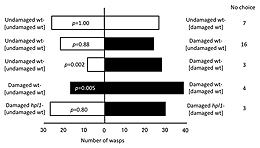Research Abstract
微量のみどりの香りに対する間欠的な曝露が植物の反応を引き起こす
Intermittent exposure to traces of green leaf volatiles triggers a plant response
2012年4月24日 Scientific Reports 2 : 378 doi: 10.1038/srep00378

植物は、傷害を受けた他の植物が放出する揮発性物質に晒されると防御応答を開始することが知られているが、この反応に必要最小限の濃度は未解明のままである。我々は、僅かな損傷を受けたArabidopsis植物体が放出する微量(140 pptV未満)のみどりの香り(green leaf volatiles)に3週間にわたって間欠的に暴露された近傍の無損傷植物体で生理的(防御)応答が誘導されることを明らかにした。この結果により、植物は極微量の化学シグナルに対する一定期間の反復的な暴露に反応して防御応答を開始する能力を持っていることが示された。
- 京都大学生態学研究センター
- 山口大学 大学院医学系研究科
- Institute for Biodiversity and Ecosystem Dynamics, University of Amsterdam(オランダ)
Plants are known to mount a defensive response when exposed to volatile chemicals from other plants, but the critical concentration required for this response is not known. We showed that intermittent exposure over a period of 3 weeks to trace amounts (less than 140 pptV) of green leaf volatiles emitted by a freshly damaged Arabidopsis plant induced physiological (defensive) responses in undamaged neighbouring plants. These results demonstrated that plants can respond to long-term repeated exposures to subcritical amounts of chemical signals.

